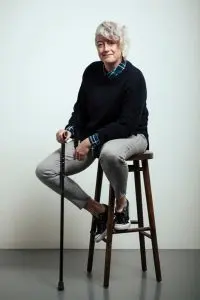In the stock photo world, images of people with disabilities tend to cluster at two poles. “They’re either depicted as superhuman or super pathetic,” says Rebecca Swift, Getty Images’ director of visual insights. “There doesn’t seem to be that broad range that you get with able-bodied people.”
Getty has seen searched for disability-related images spike in the past year–“wheelchair access” searches were up 371% from 2016 to 2017, and autism-related searches climbed 434%–and the issue of representation became impossible to ignore.

That also became clear to Oath, the parent company of Yahoo and Tumblr, as they were working to set up a website highlighting their work around accessibility in tech and having difficulty finding representative images. So the company, with consult from the National Disability Leadership Alliance, tapped Getty to help change the current representation paradigm from the inside out. Launched May 17, The Disability Collection, a new subcategory of Getty images, will feature people with disabilities in everyday settings.
What you notice first are people’s faces. In contrast to those common images that focus on a person’s hands gripping a wheelchair, or frame a blind person before a window to show what they can’t see–or depict the blur of a prosthetic leg as it strikes a track–the images in the new Getty collection focus on human interaction and people’s facial expressions.

Of course, there are challenges to capturing a range of disabilities. Visual media gravitates toward visual cues, but not all disabilities are necessarily visible. “That’s why the wheelchair tends to be the icon of disability,” Swift says. “This project for us as a business is about getting it all down and saying: Don’t just focus on wheelchairs. Think about the entire range, and think about how people with disabilities want to be depicted.”
For Getty, that meant building out a set of guidelines for photographers in their network to follow. They emphasize focusing on mundane moments from everyday–texting, taking selfies, grocery shopping. A lot of the guidelines come from focus groups with disability organizations that Oath hosted and shared with Getty. “We’ve taken input from a host of advocacy groups about how people in their communities want to be depicted,” Swift says.
Think about how easy it is to search for a stock image of a group of friends taking a selfie—and then think about how many of those images feature someone with a disability. Around 15% of people in the world have a disability, but Getty found that just 2% of stock photos contain any representation of their lives. Dramatically increasing the volume of photos that show people with disabilities in everyday settings–and falling in love, raising children, going on vacation, and leading business meetings–will start to gesture toward a more diverse reality that’s often misrepresented in media and imagery.

Oath commissioned a series of images from Nicholson to inspire the type of work that will be featured in Getty’s Disability Collection, which launched with just 50 photographs. The agency wanted to keep the original collection small, Swift says, to show “the best of the best” of what this new mode of disability photography could be. But Getty anticipates the size of the collection will rapidly grow. The guidelines, Swift says, are meant to inform their network of photographers as to how to diversify their work. When casting a family shoot or staging a typical corporate setting, for instance, photographers could incorporate more people with a variety of disabilities. “The goal is not to be tokenistic or formulaic about it,” Swift says, “but actually to be choosing people who do live with a range of disabilities, and creating an environment whereby they feel comfortable being a part of that shoot, and creating natural imagery that reflects their reality.”
And of course, that goes both ways. People with disabilities still face enormous barriers to participation in the workforce, and in many aspects of everyday life that able-bodied people often take for granted. The unemployment rate for people with disabilities, for instance, is nearly double that of able-bodied people. If more images of people with disabilities in the workplace, attending sporting events, and taking on leadership positions begin to flood the media, perhaps it will help barriers to participation in these fields come down.
Recognize your brand’s excellence by applying to this year’s Brands That Matter Awards before the early-rate deadline, May 3.
